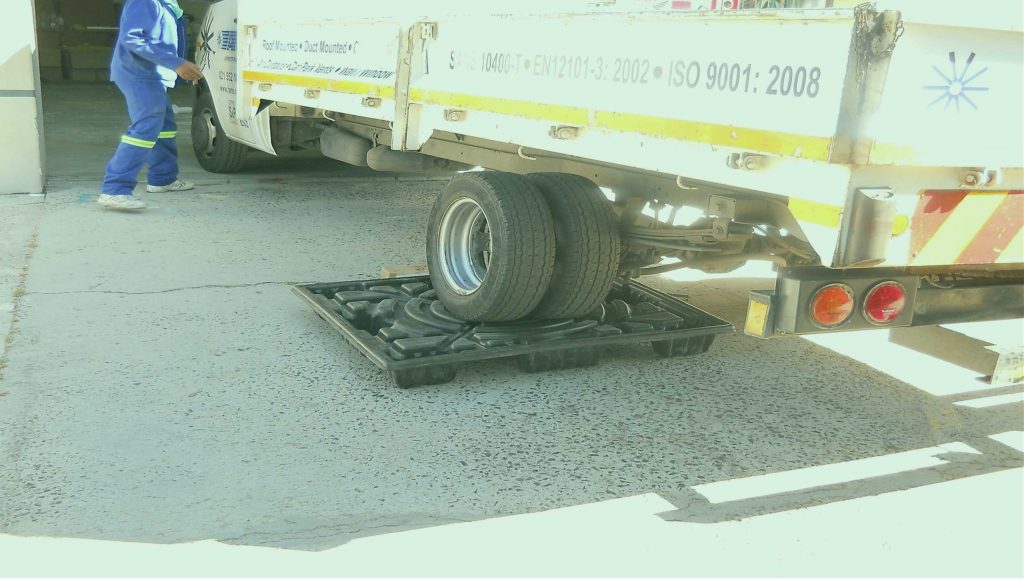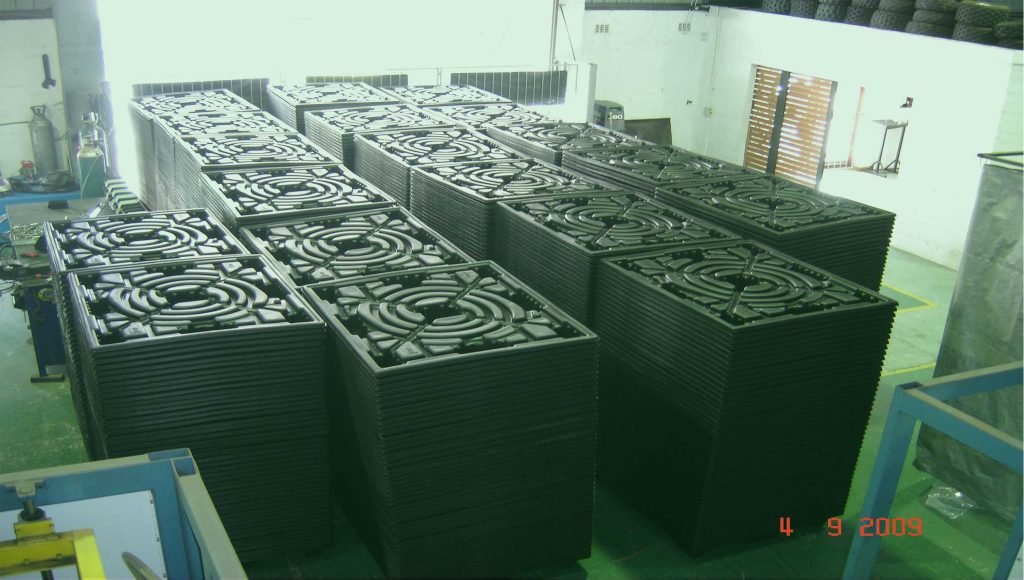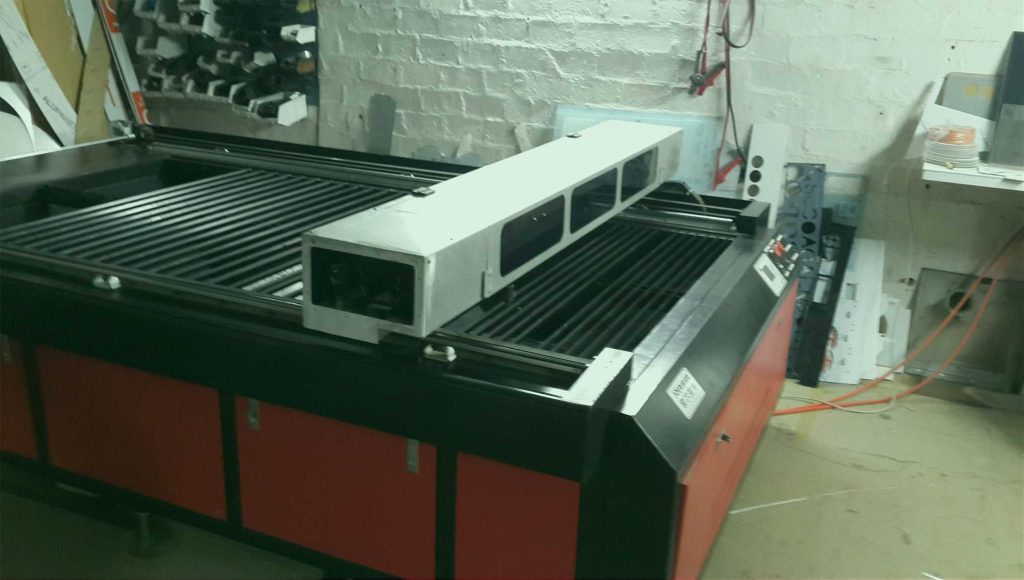Safe | Affordable | Recyclable
Established in 1996, Plastic Pallet Manufacturing has accumulated a wealth of experience in the vacuum forming, CNC routing and signage fields; plastic pallets and mould construction. With the expertise and years of experience we have in the manufacturing and design of these products and services, we can supply you with top-quality solutions in Johannesburg and Cape Town.
All our products are manufactured to export-standard and are:
- 100% recyclable
- Durable (pallets can last up to 15 years)
- Manufactured in South Africa
- Available in South Africa: Delivery in Cape Town & Johannesburg



We offer:





ECO FRIENDLY
At Plastic Pallet Manufacturing we make use of innovative methods which improve the efficiency of plastic recycling and, which turn landfill waste into biodegradable plastic. Our environment-conscious values ensure that all manufactured plastic has as little a footprint on the environment as possible. All plastic is manufactured with a 10-year guarantee, a life cycle of 25 years and is 100% recyclable.
DESIGNED TO SAVE TIME AND MONEY.
Plastic Pallet Manufacturing: Processes, Products, and Industry Insights
Plastic pallets have transformed how companies move and store goods across industries worldwide. These lightweight alternatives to wooden pallets offer superior durability, hygiene, and cost-effectiveness over time. Modern plastic pallet manufacturing combines advanced molding techniques with recycled materials to create custom solutions that can last up to 10 times longer than traditional wood pallets.
When you choose plastic pallets for your business, you’re investing in a solution that weighs as little as 12 pounds compared to wooden pallets that can weigh 30-70 pounds. They resist water, dirt, and harmful bacteria while eliminating safety hazards like splinters and protruding nails.
Understanding the manufacturing processes, design options, and leading suppliers in this industry will help you make informed decisions for your material handling needs. From injection molding to thermoforming techniques, manufacturers today offer countless customization possibilities to match your specific operational requirements.
Fundamentals of Plastic Pallet Manufacturing
Plastic pallets serve as essential material handling tools across modern industries, offering superior durability and hygiene compared to traditional wooden alternatives. These versatile platforms find widespread use in food processing, pharmaceuticals, and automated warehouse systems.
Overview of Plastic Pallets
Plastic pallets are load-bearing platforms made from recycled or virgin plastic materials. The most common materials include HDPE and PP plastics.
HDPE pallets provide excellent impact resistance and cold weather performance. They work well in cold storage facilities and chemical warehouses.
PP pallets offer higher heat resistance and rigidity. You’ll find these in applications requiring high-temperature sterilization.
Manufacturing methods vary based on your specific needs:
- Injection molding creates high-precision pallets for large-scale production
- Structural foam molding produces heavy-duty industrial plastic pallets
- Thermoforming makes lightweight pallets for wet environments
- Compression molding builds dense, strong pallets for custom applications
Load capacity determines the manufacturing approach. Light-duty pallets handle 1,000-2,000 pounds. Heavy-duty industrial plastic pallets support over 6,000 pounds when properly designed.
Key Advantages Over Wood Pallets
Plastic pallets eliminate many problems you face with wooden pallets. They don’t splinter, crack, or harbor bacteria like wood does.
Weight benefits make handling easier. Plastic pallets typically weigh 30-50% less than comparable wooden pallets. This reduces shipping costs and worker strain.
Moisture resistance prevents rot and warping. Your plastic pallets maintain their shape in humid conditions where wood would fail.
Hygiene standards meet strict food and pharmaceutical requirements. You can wash plastic pallets with hot water and sanitizing chemicals without damage.
Lifespan advantages provide better value over time. Quality plastic pallets last 5-10 years with regular use. Wood pallets often need replacement after 2-3 years.
Consistency ensures uniform dimensions every time. This reliability works better with automated systems and reduces handling problems.
Major Applications Across Industries
Food and beverage operations rely heavily on plastic pallets for safety reasons. FDA-approved materials prevent contamination in processing facilities.
Blue and white pallets show dirt easily. This helps maintain cleanliness standards in food production areas.
Cold chain logistics demand freeze-resistant materials. HDPE plastic pallets perform well in temperatures down to -40°F without becoming brittle.
Pharmaceutical manufacturing requires GMP-compliant pallets. These withstand repeated sterilization cycles at high temperatures.
Electronics assembly uses anti-static plastic pallets. Special additives prevent damage to sensitive components during transport.
Chemical processing needs acid and alkali resistant pallets. Industrial plastic pallets handle corrosive substances that would destroy wood or metal.
Automated warehouses depend on precise pallet dimensions. Consistent sizing ensures smooth operation with conveyor systems and robotic equipment.
Export operations often use recycled plastic pallets for one-time shipments. These cost-effective options reduce expenses for disposable applications.
Core Plastic Pallet Manufacturing Processes
Plastic pallet production relies on three main methods that shape molten plastic into durable products. Each process offers different benefits for cost, strength, and production volume needs.
Injection Molding
Injection molding creates the strongest and most precise plastic pallets. The process heats plastic resin to about 250 degrees Celsius in a rotating barrel.
The melted plastic gets injected into steel molds under high pressure. This pressure fills every detail of the mold cavity completely.
Key advantages include:
- High impact resistance from fork damage
- Precise dimensions every time
- Fast production once molds are ready
- Works best for large orders over 50,000 units
Most manufacturers use virgin or high-quality recycled resin for injection molding. This creates durable plastic pallets that last longer in tough conditions.
The main drawback is cost. You need standard pallet designs to justify the expensive molds and equipment.
Rotational Molding
Rotational molding works well for smaller production runs and custom designs. The process puts plastic powder inside a mold that rotates slowly.
Heat melts the powder as the mold turns in multiple directions. This creates even wall thickness throughout the plastic pallet.
Benefits include:
- Lower mold costs than injection molding
- Good for unique pallet shapes
- Strong corner construction
- Works with smaller order quantities
The process takes longer than injection molding. Wall thickness can vary slightly between different areas of the pallet.
Thermoforming
Thermoforming offers the lowest cost manufacturing option. Heated plastic sheets get pulled into molds using vacuum pressure.
This method works well for lightweight products that don’t carry heavy loads. The plastic stays flexible and handles fork impacts without breaking.
Process features:
- Cheapest manufacturing method
- Good flexibility and fork resistance
- Limited to simpler pallet designs
- Poor performance with heavy weights
Many nestable pallets use thermoforming because the thin walls stack together easily.
Use of Recycled Materials
Recycled plastic helps reduce costs and environmental impact in pallet manufacturing. Most plastic pallets contain some percentage of recycled content.
Common recycled materials include:
- Post-consumer HDPE containers
- Industrial plastic waste
- Reprocessed pallet material
Manufacturers blend recycled content with virgin plastic to maintain strength. Typical ratios range from 25% to 75% recycled material depending on the application.
Quality control tests ensure recycled materials meet performance standards. The recycled content gets cleaned and sorted before melting with new plastic.
Using recycled materials can reduce pallet costs by 10-20% compared to all-virgin plastic construction.
Types of Plastic Pallets and Their Applications
Plastic pallets come in three main design categories that serve different business needs. Rackable pallets handle heavy loads in warehouse storage systems, stackable pallets maximize floor storage space, and nestable pallets save space when empty.
Rackable Plastic Pallets
Rackable plastic pallets are built to support heavy loads when placed on warehouse storage racks. These heavy duty plastic pallets feature reinforced construction with extra support beams and thick deck surfaces.
You’ll find these pallets in distribution centers and warehouses where goods need long-term storage. They handle static loads up to 5,000 pounds and racking loads between 2,500-3,000 pounds.
Key applications include:
- Warehouse storage systems
- Distribution centers
- Manufacturing facilities
- Automotive parts storage
The reinforced design makes rackable pallets more expensive than other types. However, their durability and load capacity make them cost-effective for heavy-duty applications.
Many rackable pallets also serve as hygiene pallets in food and pharmaceutical industries. Their smooth surfaces resist bacteria and clean easily with sanitizers.
Stackable Plastic Pallets
Stackable plastic pallets feature solid deck construction that allows stable stacking when loaded with goods. The flat bottom design creates a secure base for the pallet above it.
You can stack these pallets 4-6 high depending on the load weight and pallet strength. This design works well for bulk storage and logistics operations where floor space is limited.
Common uses include:
- Bulk product storage
- Cold storage facilities
- Retail backroom storage
- Export shipping
Stackable pallets typically handle dynamic loads of 2,200-3,300 pounds. The solid construction makes them heavier than nestable designs but more durable for repeated use.
Plastic euro pallets often use stackable design to meet European shipping standards. These measure 1200mm x 800mm and work with standard European logistics equipment.
Nestable Plastic Pallets
Nestable plastic pallets feature angled sides that allow empty pallets to nest inside each other. This design can reduce storage space by up to 80% when pallets are empty.
The tapered sides mean these pallets have lower load capacities than rackable or stackable types. Most handle dynamic loads between 1,500-2,500 pounds.
Best applications include:
- One-way shipping
- Retail distribution
- Export operations
- Temporary storage needs
You’ll save significant space in storage areas and transportation when moving empty pallets. A truck that holds 20 regular pallets can carry 100+ nested pallets.
Nestable pallets cost less than other types but have shorter lifespans. They work best for applications where space savings outweigh durability needs.
Leading Plastic Pallet Manufacturers
The plastic pallet industry features several established companies that serve different market segments and specialties. ORBIS Corporation leads the market with comprehensive solutions, while various competitors offer specialized products and regional expertise.
ORBIS Corporation
ORBIS Corporation stands as one of the most recognized names in plastic pallet manufacturing. The company provides high-quality alternatives to traditional wood pallets across multiple industries.
Their product line includes nestable, stackable, and rackable plastic pallets. You can also find top frames and top caps in their inventory. ORBIS designs custom solutions for your shipping, transfer, and display needs.
The company focuses on economic and efficient alternatives. Their ProStack line offers specific solutions for different warehouse operations. ORBIS serves clients who need reliable material handling equipment.
Their pallets work well in food processing, pharmaceuticals, and retail distribution. You get consistent quality and performance from their manufacturing processes.
Major Industry Competitors
Several companies compete with ORBIS in the plastic pallet market. Monoflo International ranks as the top plastic pallet company as of September 2025. The Nelson Company holds the second position in industry rankings.
US Plastic Pallets & Handling takes third place among leading manufacturers. AmeriPallets focuses on the North American market with high-quality products and slip sheets.
Enlightening Plast operates as a factory-direct manufacturer. They have over 20 years of experience and run a 75,000 square meter production facility. Their injection molding and welding systems serve global clients.
These companies offer different specialties and regional coverage. Some focus on custom solutions while others provide standard sizes and designs.
Criteria for Selecting a Manufacturer
You should evaluate several factors when choosing a plastic pallet manufacturer. Product durability ranks as the most important consideration since plastic pallets must handle repeated use and heavy loads.
Check the manufacturer’s size options. Type 11 pallets measure 1100mm x 1100mm squares. Type 14 pallets use 1400mm x 1100mm rectangles. Some companies offer smaller pallets under 1000mm or larger ones over 2000mm.
Manufacturing experience matters for consistent quality. Look for companies with established production processes and quality control systems. Your supplier should have proper injection molding equipment.
Consider their recycling programs and environmental practices. Many plastic pallets can be crushed and processed into pellets for reuse. This supports your sustainability goals and reduces waste disposal costs.
Design and Customization Options
Plastic pallet manufacturers offer various design choices to meet different business needs. Companies can choose between ready-made solutions or work with manufacturers to create custom designs that match their specific requirements.
Standard vs. Custom Plastic Pallets
Standard plastic pallets come in common sizes like 48×40 inches and 42×42 inches. These pallets work well for most shipping and storage needs. They cost less and ship faster than custom options.
Custom plastic pallets solve specific problems that standard sizes cannot fix. You can change the dimensions, weight capacity, and deck design. Custom options include special features like anti-slip surfaces, reinforced corners, or unique stacking patterns.
Manufacturing companies create custom designs using computer software. This software tests how much weight the pallet can hold. It also shows how the pallet will perform during shipping and storage.
The choice between standard and custom depends on your budget and needs. Standard pallets work for basic operations. Custom pallets make sense when you have special size requirements or use automated systems.
Product-Specific Requirements
Different products need different pallet designs. Food companies often need pallets that resist bacteria and wash easily. Chemical companies require pallets that handle corrosive materials safely.
Weight capacity varies based on what you ship. Light products like plastic containers need basic pallets. Heavy machinery requires reinforced designs with extra support beams.
Pallet deck styles affect how products sit on top. Solid decks work best for small items that might fall through gaps. Slatted decks allow air flow for products that need ventilation.
Some industries have strict rules about pallet materials. Food processing plants cannot use pallets with certain chemicals. Export shipments need pallets that meet international shipping standards.
Integration with Supply Chain Systems
Modern warehouses use automated systems that need specific pallet features. RFID tags can be built into plastic pallets for tracking. Bar codes help identify pallets as they move through facilities.
Pallet dimensions must match your conveyor systems and storage racks. Standard forklift spacing requires specific notch sizes and depths. Automated guided vehicles need pallets with precise measurements.
Stacking features help maximize storage space. Some pallets nest together when empty to save room. Others stack in columns to organize full loads efficiently.
Color coding helps workers identify different product types quickly. Custom branding options include company logos and part numbers molded into the pallet surface.
Quality, Safety, and Regulatory Considerations
Plastic pallet manufacturing must meet strict quality standards for load capacity and durability testing. Food-grade and hygienic applications require specific materials and design features to prevent contamination and meet regulatory compliance.
Durability and Load Capacity
Durable plastic pallets undergo rigorous testing to determine their load limits. Manufacturers test three key capacity types: dynamic loads (while moving), static loads (while stationary), and rack loads (in storage systems).
ISO 8611-2:2021 sets the international standard for pallet performance testing. This standard helps determine nominal loads for new flat pallets in different handling environments.
Your plastic pallets must pass stress testing and load analysis to prevent structural failures. Quality manufacturers conduct these tests:
- Dynamic load testing – measures capacity while forklifts move pallets
- Static load testing – tests weight limits when pallets sit motionless
- Rack load testing – evaluates performance in warehouse racking systems
Most industrial plastic pallets handle 2,000 to 4,000 pounds safely. Heavy-duty models can support up to 10,000 pounds or more.
Hygienic and Food-Grade Pallets
Food industry regulations require hygiene pallets made from virgin-grade plastic materials. The British Retail Consortium (BRC) mandates virgin plastic when containers contact food products directly during processing.
Hygiene pallets feature completely smooth, closed surfaces with no crevices where bacteria can hide. Their non-porous design resists liquids, dirt, and odors that could cause contamination.
Key hygienic features include:
- Smooth, seamless construction
- Easy-to-clean surfaces
- Resistance to chemicals and sanitizers
- No nails or fasteners that could harbor bacteria
Pharmaceutical companies must follow Good Manufacturing Practices (GMP) and Good Distribution Practices (GDP). Your plastic pallets help meet these standards through easy cleaning and sterilization capabilities.
HACCP (Hazard Analysis and Critical Control Point) systems identify pallets as potential contamination sources. Using hygienic plastic pallets reduces these risks significantly.
Environmental Sustainability
Sustainable plastic pallet manufacturing balances environmental responsibility with regulatory requirements. Most manufacturers use 96% recycled household and business plastic waste for standard pallets.
Virgin plastic remains necessary for direct food contact applications due to traceability requirements. These virgin plastic pallets typically last 10+ years before needing replacement.
End-of-life recycling programs allow manufacturers to collect used pallets and professionally recycle them instead of sending them to landfills. This creates a circular economy for plastic pallet materials.
Your export operations benefit from plastic pallets’ ISPM15 exemption. Unlike wooden pallets, plastic pallets don’t require heat treatment, stamping, or pest control certification for international shipping.
This exemption reduces regulatory compliance costs and eliminates treatment delays. Eighty-five countries worldwide recognize ISPM15 regulations for wooden packaging materials.
Frequently Asked Questions
Plastic pallet manufacturing involves specific production methods, materials, and standards that affect performance and cost. Understanding these factors helps you make informed decisions about capacity, regulations, and environmental impact.
What are the main steps involved in the production process of plastic pallets?
The manufacturing process begins with melting plastic resin pellets at high temperatures. The molten plastic gets fed into injection molding machines or structural foam molding equipment.
During injection molding, the liquid plastic fills steel molds shaped like pallet components. The molds cool the plastic until it hardens into the final shape.
Structural foam molding creates lighter pallets by injecting nitrogen gas into the molten plastic. This process makes pallets with solid outer shells and foam cores.
After molding, workers remove excess plastic and inspect each pallet for defects. Quality control teams test the pallets for weight capacity and durability before shipping.
Which types of plastic materials are commonly used in manufacturing plastic pallets?
High-density polyethylene (HDPE) is the most common material for plastic pallets. HDPE offers strong impact resistance and works well in cold temperatures.
Polypropylene (PP) provides flexibility and chemical resistance. Many manufacturers use PP for pallets that carry chemicals or food products.
Recycled plastic materials help reduce costs and environmental impact. These recycled resins maintain good strength while using fewer new resources.
Some manufacturers blend different plastic types to create specific properties. These blends can improve strength, flexibility, or chemical resistance based on your needs.
How does the weight carrying capacity of plastic pallets compare to wooden pallets?
Plastic pallets typically support between 2,000 and 5,000 pounds of static weight. Dynamic loads during transport usually range from 1,500 to 3,000 pounds.
Standard wooden pallets handle similar weight ranges but performance varies more. Wood quality and moisture content affect how much weight wooden pallets can carry.
Plastic pallets maintain consistent strength over time. They don’t weaken from moisture, insects, or fungal growth like wooden pallets do.
The design of plastic pallets affects their capacity more than the material itself. Ribbed bottoms and reinforced corners increase weight limits significantly.
What are the economic and environmental benefits of switching to plastic pallets from traditional materials?
Plastic pallets last 5 to 10 times longer than wooden pallets. This longer life span reduces replacement costs and purchasing frequency.
You avoid fumigation costs when shipping internationally with plastic pallets. Wood pallets require expensive fumigation treatments to meet international regulations.
Plastic pallets weigh less than wooden pallets, reducing shipping costs. The weight savings can add up to significant transportation savings over time.
Recycled plastic pallets reduce landfill waste and use fewer new materials. Many plastic pallets contain 25% to 100% recycled content.
Can plastic pallets be recycled at the end of their life cycle, and what is the process for recycling?
Most plastic pallets can be recycled into new pallets or other plastic products. The recycling process begins by sorting pallets by plastic type and color.
Workers shred the old pallets into small plastic flakes. These flakes get washed to remove dirt, labels, and other contaminants.
The clean plastic flakes melt down into new resin pellets. Manufacturers can use these recycled pellets to make new pallets or other products.
Some companies offer take-back programs where they collect and recycle their own pallets. This closed-loop system ensures proper recycling and reduces waste.
What regulations and standards must plastic pallets meet for use in international shipping?
Plastic pallets are exempt from ISPM15 regulations that apply to wooden packaging materials. This exemption eliminates the need for heat treatment or fumigation before international shipping.
FDA regulations apply to plastic pallets used in food and pharmaceutical industries. These pallets must use food-grade materials and meet specific cleanliness standards.
ISO 8611 standards define dimensions and testing methods for plastic pallets. These standards ensure pallets work with standard handling equipment worldwide.
Different countries may have specific requirements for plastic materials and additives. You should verify local regulations before using plastic pallets in new markets.
